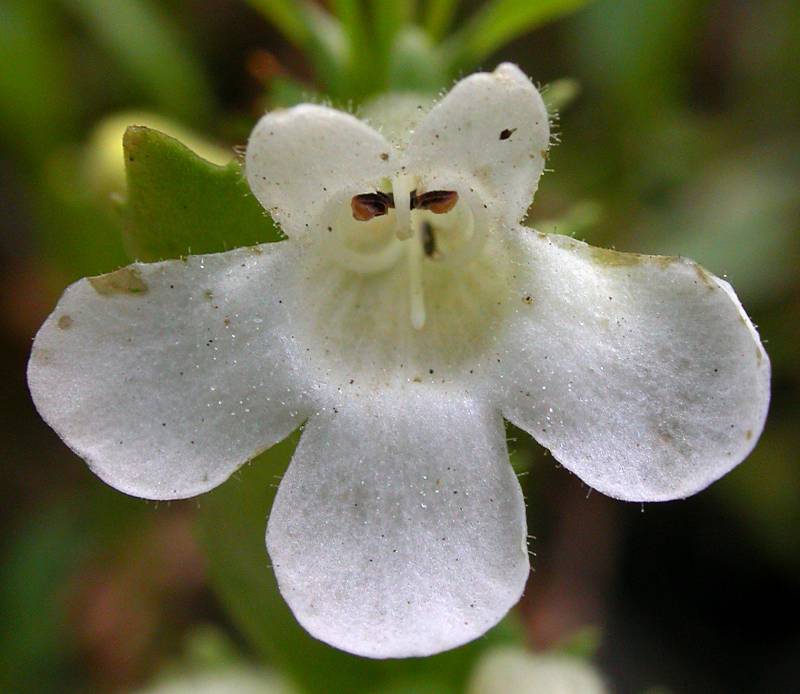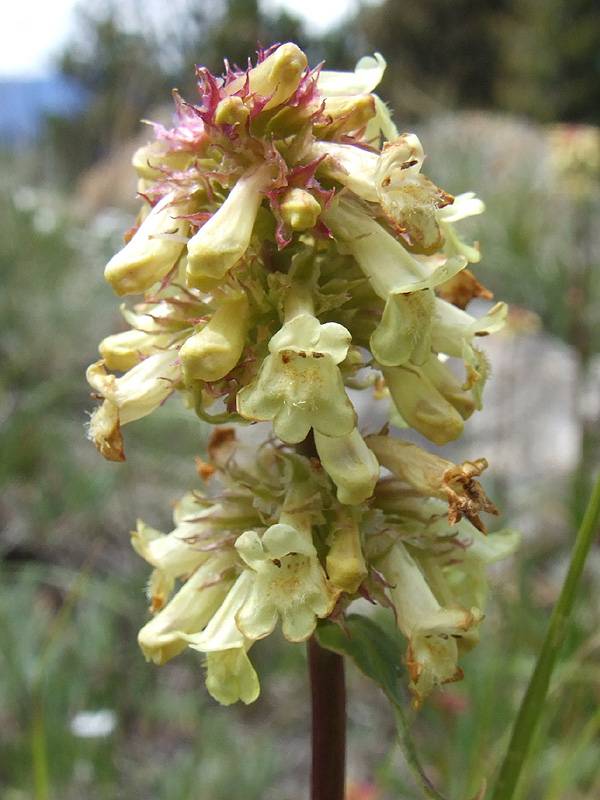|
hot-rock penstemon
|
lesser yellow beardtongue
|
| Plants with a much-branched, woody base, the flowering stems simple and erect, 2-6 dm. tall; plants usually glandular in the inflorescence, otherwise glabrous. |
Tufted perennial from a woody rhizome, the stems 2-5 dm. tall, mostly glabrous. |
Leaves opposite, ternate, whorled or scattered, sharply toothed to entire; leaves on the short, sterile shoots oblanceolate to elliptic and short-petiolate, those on the flowering stems usually sessile and broad-based, up to 6 cm. long and 2.5 cm. wide. |
Leaves opposite, entire, the lower ones petiolate, up to 15 cm. long and 2.5 cm. wide and forming a rosette; cauline leaves sessile, lanceolate to oblong-lanceolate, up to 10 cm. long and 2.5 cm. wide. |
Inflorescence of several verticillasters, often rather loose; calyx 2.5-6 mm. long, the 5 segments lanceolate; corolla dull whitish with some purplish lines within, sometimes washed with lavender, 8-20 mm. long, the tube narrow; staminode glabrous or hairy, not expanded toward the tip; pollen sacs 0.5-0.9 mm. long, glabrous, dehiscent throughout, widely spreading. |
Inflorescence of 2-10 compact verticillasters, the lower remote; bracts of the inflorescence with uneven margins; calyx 3-5 mm. long, the 5 segments with broad, uneven margins and a abrupt, slender tip; corolla ochroleucous or light yellow, 8-12 mm. long, the tube narrow, 2-3.5 mm. wide at the mouth, the short limb weakly bilabiate, the staminode and raised lower petal bearded; pollen sacs purple, glabrous, 0.4-0.7 mm. long, becoming opposite. |
Capsule 3-5 mm. long. |
Capsules 4-5 mm. long. |
|
|
|
|
| May-July |
May-August |
| Open rocky roadsides, hillsides, and rock outcrops, sometimes in dry meadows, lowland to middle elevations in the mountains. |
Coniferous forest openings and open slopes from low to middle elevations. |
Occurring east of the Cascades crest in Washington; British Columbia to California, east to Montana and Utah.
|
Occurring chiefly east of the Cascades crest in Washington; British Columbia to Oregon, east to Alberta, Idaho and Montana.
|
| Native |
Native |
| Not of concern |
Not of concern |
P. acuminatus, P. attenuatus, P. barrettiae, P. cardwellii, P. cinereus, P. confertus, P. davidsonii, P. ellipticus, P. eriantherus, P. euglaucus, P. fruticosus, P. gairdneri, P. glandulosus, P. hesperius, P. lyallii, P. ovatus, P. palmeri, P. pennellianus, P. procerus, P. pruinosus, P. richardsonii, P. rupicola, P. rydbergii, P. serrulatus, P. speciosus, P. subserratus, P. triphyllus, P. venustus, P. washingtonensis, P. wilcoxii |
P. acuminatus, P. attenuatus, P. barrettiae, P. cardwellii, P. cinereus, P. davidsonii, P. deustus, P. ellipticus, P. eriantherus, P. euglaucus, P. fruticosus, P. gairdneri, P. glandulosus, P. hesperius, P. lyallii, P. ovatus, P. palmeri, P. pennellianus, P. procerus, P. pruinosus, P. richardsonii, P. rupicola, P. rydbergii, P. serrulatus, P. speciosus, P. subserratus, P. triphyllus, P. venustus, P. washingtonensis, P. wilcoxii |
|
|
| |



